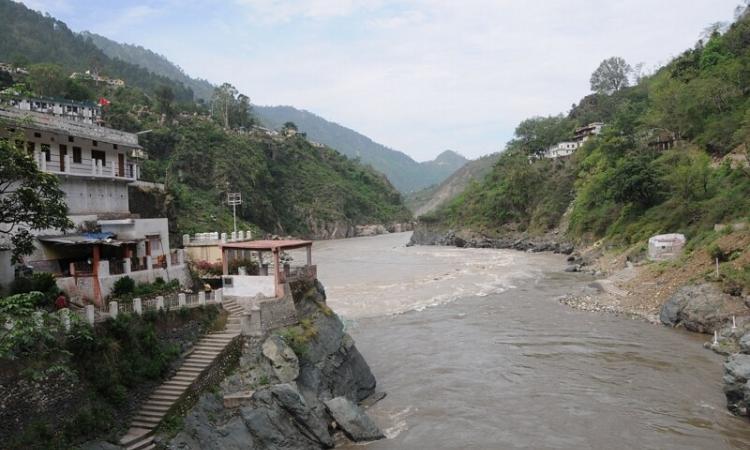
After heavy rains, four major rivers change course in Uttarakhand
The Kosi, Gaula, Nandhaur, and Dabka rivers in Uttarakhand have changed course, after heavy rains lashed the state last week. These rivers are currently flowing toward human habitations in some areas while in other areas, the change of course is affecting works of the forest department such as mining and patrolling. The Forest Department has asked IIT- Roorkee to analyse the changes in the course of these rivers.
According to Himanshu Thakkar, coordinator of South Asia Network on Dams, Rivers & People, “The rivers have not changed their course or taken up new channels, they are simply flowing in their own space – the riverbed – which humans have encroached upon.”(The Times of India)
PM Modi makes five big promises at COP26 summit
In his national address as 'representative' of developing nations, Prime Minister Modi outlined a five-point plan to fight global warming and climate change.
He announced that India will bring its non-fossil energy capacity to 500 GW by 2030. Second, by 2030 India will fulfill 50percent of its energy requirement through renewable energy. The third step is to reduce India's net projected carbon emissions by 1 billion tonnes by 2030. Fourth, India will reduce carbon intensity of its economy by over 45% by 2030. Finally, by 2070 India will achieve the target of ‘net zero’.
More than 120 heads of state and government are gathering in Glasgow for a two-day summit at the start of the UN’s COP26 conference. (News 18)
Ageing dams become a rising global concern: UN report
In its 'Ageing Water Storage Infrastructure: An Emerging Global Risk ', the United Nations University - Institute for Water, Environment and Health (UNU-INWEH) has reported that over 10,000 dams across the world have reached the "alert" age limit, which is 50 years and several others are nearing 100 years. China, Japan, India and South Korea contribute 55 percent of the dams in the world, and most of these are approaching their 50-year limit.
The report further informed that in India, around 4,250 large dams will be over 50-years-old in 2015; 64 large dams will be over 150-years-old in 2050 and mentioned that the Mullaperiyar dam in Kerala, which was built on the Periyar river in 1895, is also in danger. In addition to being located in a seismically active area, the dam shows significant structural flaws and may be at risk of failure. (The Times Now)
India lost $87 billion in 2020 to climate disaster, second only to China, finds report
The World Meteorological Organisation (WMO) noted in its State of the Climate in Asia report that India had suffered losses of $87 billion last year due to disasters like cyclones, floods, and droughts. India's loss was second to China's, which lost $238 billion. The past year was the warmest on record in Asia, with a mean temperature 1.39 degrees Celsius above the average from 1981 to 2010, highlighting the upcoming climate crisis.
Furthermore, according to the Climate Vulnerability Index by the Council on Energy, Environment and Water (CEEW), Assam, Andhra Pradesh, Maharashtra, Karnataka and Bihar are most vulnerable to extreme climate events such as floods, droughts and cyclones in India.
There are 27 states and union territories in India that are vulnerable to extreme climate events, which often disrupt local economies and displace weaker communities. (Hindustan Times)
Tribals against power projects in Mandi, to opt for NOTA as a protest
Environmental activists in tribal regions are disappointed that neither party has included the threat to the fragile ecology of Mandi in its agenda and are urging people to choose the NOTA option to voice their dissatisfaction. Due to the construction of mega power projects, villages such as Nathpa, Kandhar, Urni and Pangi are at risk of landslides. A major demonstration was also held a few months ago against all proposed hydroelectric projects in the Sutlej river valley.
There has been an ecological imbalance due to the state's ambitious hydropower projects on the Sutlej river, which is affecting the livelihood of residents and increasing the probability of disasters.
Tribals have also been demanding implementation of the Forest Rights Act for a long time, but no party has a clear stance on it. (Hindustan Times)
Karnataka and Rajasthan top the State Energy Efficiency Index for 2020
Karnataka topped the State Energy Efficiency Index 2020 (SEEI) with 70 points out of 100, followed by Rajasthan, Haryana, Punjab, Maharashtra, Kerala, Tamil Nadu, and Andhra Pradesh.
The Ministry of Power's (MoP) Energy Efficiency Index ranks states on 68 indicators and assesses their performance on policies and regulations, financing mechanisms, institutional capacity, adoption of energy efficiency measures, and energy savings. A total of 27 states and union territories improved their scores. Seven states – Assam, Andhra Pradesh, Karnataka, Maharashtra, Punjab, Rajasthan, and Tamil Nadu – improved their scores by over 10 points. The second-highest performer, Rajasthan, is the only state to have constituted an ECBC cell in its Public Works Department (PWD). (Mercom India, Business Standard)
This is a roundup of important news published from October 19 - November 5, 2021. Also read policy matters this fortnight.